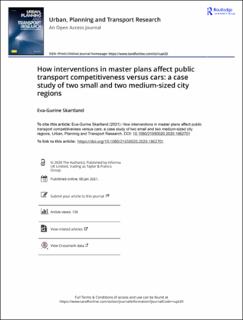| dc.contributor.author | Skartland, Eva-Gurine | |
| dc.coverage.spatial | Norway, Oslo | en_US |
| dc.date.accessioned | 2021-01-19T16:31:04Z | |
| dc.date.available | 2021-01-19T16:31:04Z | |
| dc.date.created | 2021-01-13T13:58:46Z | |
| dc.date.issued | 2021-01-08 | |
| dc.identifier.citation | Urban, Planning and Transport Research. 2021, . | en_US |
| dc.identifier.issn | 2165-0020 | |
| dc.identifier.uri | https://hdl.handle.net/11250/2723773 | |
| dc.description.abstract | Many spatial master plans aim at reducing car traffic and increasing public transport use, but whether the plans truly promote such development is not obvious because they may also include conflicting objectives. The purpose of this article is to propose and use a theory-based framework to analyze and discuss the possible effects of planned development in master plans on public transport competitiveness versus cars. Official planning documents and interviews with local planners in the city regions of Stavanger, Trondheim, Hamar, and Haugesund were interpreted using theory on causal mechanisms and previous empirical studies on the built environment and travel behavior. A simple map analysis was also conducted. The study revealed that all the case city regions’ master plans contain interventions that are both negative and positive for public transport competitiveness. Conflicting interventions often reduce such competitiveness. The possible effects of interventions also largely depend on their context, dimension, and location. | en_US |
| dc.language.iso | eng | en_US |
| dc.publisher | Published by Informa UK Limited, trading as Taylor & Francis Group. | en_US |
| dc.rights | Navngivelse 4.0 Internasjonal | * |
| dc.rights.uri | http://creativecommons.org/licenses/by/4.0/deed.no | * |
| dc.title | How interventions in master plans affect public transport competitiveness versus cars: a case study of two small and two medium-sized city regions | en_US |
| dc.type | Journal article | en_US |
| dc.type | Peer reviewed | en_US |
| dc.rights.holder | © 2020 The Author(s). | en_US |
| dc.description.version | publishedVersion | en_US |
| cristin.ispublished | true | |
| cristin.fulltext | original | |
| cristin.qualitycode | 1 | |
| dc.identifier.doi | 10.1080/21650020.2020.1862701 | |
| dc.identifier.cristin | 1870703 | |
| dc.source.journal | Urban, Planning and Transport Research | en_US |
| dc.source.pagenumber | 31 | en_US |
| dc.relation.project | Norges forskningsråd: 268086 | en_US |

